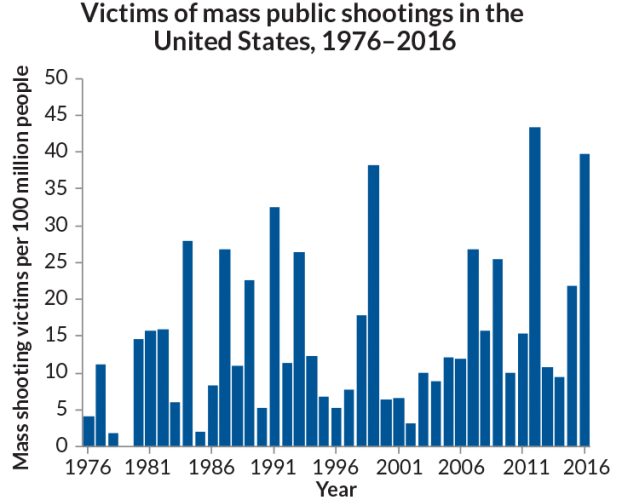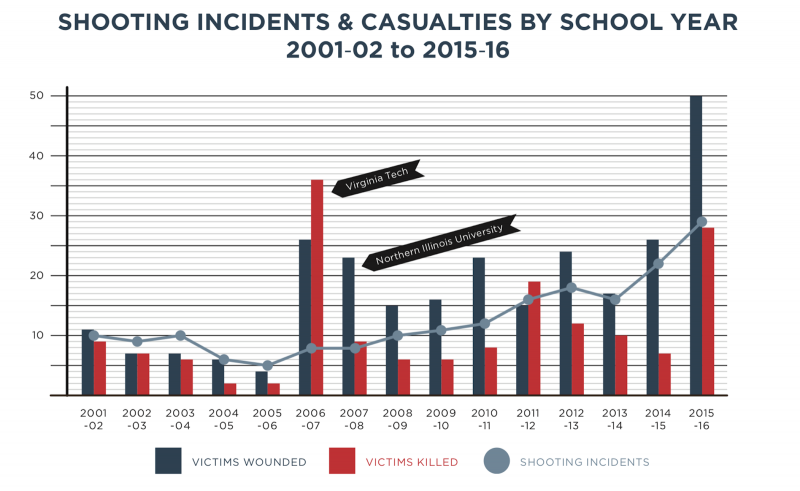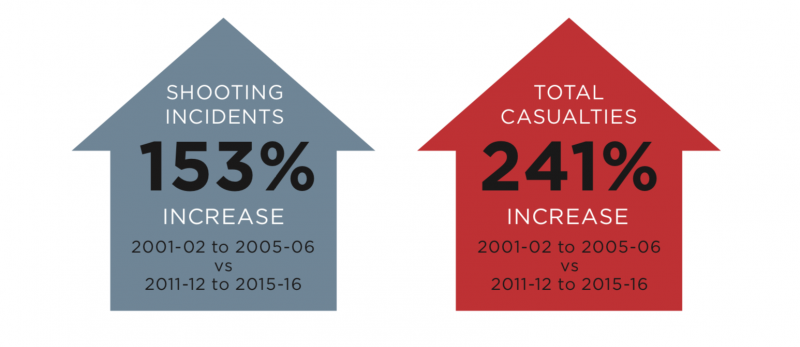
Officer Hamline instructs members of the William Jewell College community on how to respond in the event of an active shooter on campus.
Approximately 20 people dotted Yates-Gill Room 221/222 on the evening of Aug. 28 while Officer Kyle Hamline from the Liberty Police Department held an active shooter training course. The training was open to faculty, students and staff and was the second of two courses, the first being held Aug. 14.
Hamline began the course with a brief overview of past shootings and explained that the victim count in these events could have been reduced had victims received proper training to defend themselves against attack.
“The purpose of this course is to give you the mindset to take action,” Hamline said.
Liberty Police Department utilizes FBI tactics, based upon analysis of past mass shootings, in their active shooter training courses. Officer Hamline outlined three defense tactics that should be used in the event of an active shooting: “Run. Hide. Fight.”
The Department of Homeland Security details this three-point plan on their emergency preparedness site. The plan emphasizes the chronology of “Run. Hide. Fight.,” recommending that victims try to run from the scene before anything else and, if escape is not possible, to hide in a secure area with lights turned off, phone on vibrate and doors locked and reinforced against intruders by heavy objects, like copy machines or tables and chairs. If these options are impossible, victims should fight as a last resort using whatever objects available to incapacitate the shooter.
Officer Hamline, using a table pre-set with items ranging from golf balls to fidget spinners, offered various ways to attack a shooter. He demonstrated with Jacob Shutts, sophomore Oxbridge: Institutions and Policy and economics major how an everyday item like a belt could make all the difference in preventing a shooter from entering a room.

Officer Hamline demonstrates using a belt for leverage to ensure that a door cannot be pulled open from the outside.
Shutts was one among the several resident assistants who made up the majority of the 20 individuals who attended the training. Officer Hamline noticed the dozens of empty seats in the room and explained that so many people choose not to attend training courses like this because, when considering being involved in an active shooter event, their mentality is “if” and not “when.”
“We have to be in the mindset of when it does happen,” Hamline said.
Hamline repeatedly emphasized the importance of awareness and said that, had people reported past perpetrators’ suspicious behavior, many mass shootings could have been prevented.
“When you see that kid that’s getting ready to explode – when they’re not having resilience … You guys have got to be watching,” Hamline said.
Though the sole purpose of the course is to give students the knowledge necessary to defend themselves in an instance of immediate danger, Liberty Police Department makes an effort to connect mentally unstable individuals to the appropriate authorities to stem attacks before they are carried out.
“We’re actually talking to those kids that have the killing mindset, and we’re getting them help,” Hamline said. “They’re getting psychological help. They’re getting parental help. They’re meeting with school counselors.”
Among the community that researches mass shootings, a consensus has been reached that defines a mass shooting as an isolated, public incident that results in the death of four or more people by a firearm.
Besides defining what a mass shooting is, however, researchers have not made much progress in determining why they happen, most likely due to minimal federal funding and the classification of mass shootings under general homicide research.
Trends can be tracked, however, and one of the most concerning shows an evident uptick in the amount of victims per mass shooting.

Graph courtesy of sciencenews.com
Mass shootings have also increased in frequency over the past few years, though these increases are comparative to others in the past. Still, combined with the fact that they are getting more deadly, campus safety organizations believe it is more important than ever to offer training courses to prepare students to defend themselves in the event of a mass shooting.

Graph courtesy of nycrimecommission.org

Graph courtesy of nycrimecomission.org
College gun violence in particular has skyrocketed since the millennium began. The increase was most profound in southern states and states that had more lax firearm acquisition laws.
While safety organizations advocate the implementation of active shooter training courses and other safety procedures, it is hard to tell how effective these precautions are at reducing casualties and preventing attacks, especially as mass shootings become deadlier and more frequent.
Some psychologists have even raised concerns about the psychological impact of going through active shooter training courses. One psychological study showed that, though students felt more prepared after watching a training video, they also experienced increased fear about being a victim in an active shooter situation.
Researchers who fear the implications of exposing students, especially the younger and more vulnerable ones, to the prospect of being a victim of a mass shooting advocate the redirection of school safety funds away from active shooter courses and toward less tangible tactics to prevent school shootings at their source, such as anti-bullying and mental health initiatives.
Still, the debate over the best response to the increasing severity of mass shootings does not have a clear leading player. In the face of this epidemic for which science offers no concrete explanations, schools are attempting to protect their students.
Photos courtesy of Sofia Arthurs-Schoppe.
